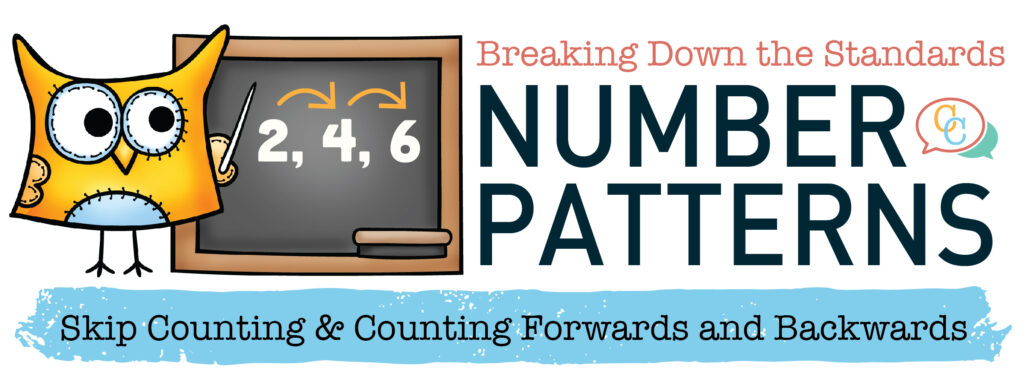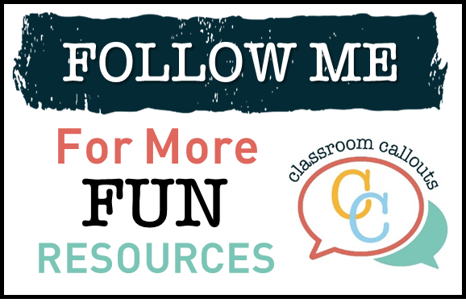Welcome to the Breaking Down the Standards Series. In this post, we will cover the teaching of Number Patterns in first grade. This can mean counting forward, backward, and skip counting by 2s, 5s, and 10s. It can also include determining a number that is 10 more and 10 less than a given number.
Mastering Number Patterns
Are you tired of teaching number patterns in the same old way? If you’re looking to engage your students and help them build strong mathematical skills, you’re in the right place. In this article, we’ll explore creative strategies for using algebraic reasoning to identify and apply relationships between numbers. From skip counting with base ten blocks to problem-solving activities, we’ll provide you with a roadmap to mastering number patterns.
First Grade Number Patterns Standards:
First Grade
Common Core
- Count to 120, starting at any number less than 120. In this range, read and write numerals and represent a number of objects with a written numeral
- Given a two-digit number, mentally find 10 more or 10 less than the number, without having to count; explain the reasoning used
- Subtract multiples of 10 in the range 10-90 from multiples of 10 in the range 10-90 (positive or zero differences), using concrete models or drawings and strategies based on place value, properties of operations, and/or the relationship between addition and subtraction; relate the strategy to a written method and explain the reasoning used.
TEKS
- Recite numbers forward and backward from any given number between 1 and 120
- Skip count by twos, fives, and tens to determine the total number of objects up to 120 in a set
- Use relationships (patterns) to determine the number that is 10 more and 10 less than a given number up to 120

The Vertical Alignment:
When introducing number relationships and patterns, it’s important to know what the student already knows and what they should know when they leave first grade. The TEKS and Common Core Standards differ slightly but have one common goal; to teach number relationships by recognizing patterns. Some of the standards were covered in the Breaking Down the Standards Place Value post.
Kindergarten:
Common Core
- Students will count to 100 by ones
- Skip Count by tens to 100
TEKS
- Count forward and backward to at least 20 with and without objects
- Generate a number that is one more than or one less than another number up to at least 20
First Grade
Common Core
- Count to 120, starting at any number less than 120. In this range, read and write numerals and represent a number of objects with a written numeral
- Given a two-digit number, mentally find 10 more or 10 less than the number, without having to count; explain the reasoning used
- Subtract multiples of 10 in the range 10-90 from multiples of 10 in the range 10-90 (positive or zero differences), using concrete models or drawings and strategies based on place value, properties of operations, and/or the relationship between addition and subtraction; relate the strategy to a written method and explain the reasoning used.
TEKS
- Recite numbers forward and backward from any given number between 1 and 120
- Skip count by twos, fives, and tens to determine the total number of objects up to 120 in a set
- Use relationships (patterns) to determine the number that is 10 more and 10 less than a given number up to 120
Second Grade
Common Core
- Mentally add 10 or 100 to a given number 100–900, and mentally subtract 10 or 100 from a given number 100–900
TEKS
- Locate the position of a given whole number on an open number line
- Name the whole number that corresponds to a specific point on a number line
The Breakdown:
Teaching number patterns in first grade will be one of the easier standards for teachers. The objectives are pretty clear cut and actually a great deal of fun for students to practice.
When first graders leave first grade, they should be able to count to 120 starting anywhere. This skill results in kids needing to know the number before or after a given number. In essence, the number pattern. They will also be able to count backward within 120 as well as skip count using 2s, 5s and 10s. More than likely, they learned how to count by 10s in Kindergarten. Counting by 2s will be the most difficult of the skip counting objective. Finally, they will recite a number ten more and ten less than a given number without the use of a 120 chart. Of course, you must start with the chart so they will see the patterns and relationships between the numbers. Based on student need, gradually remove the chart to see if they have mastered the skill.
The Progression: Easiest to Hardest
This is just my opinion. Choose the progression based on the needs of your class.
- Counting Forward to 120
- Skip Count by 10
- Skip Count by 5
- Count Backward within 120
- Skip Count by 2
- Determine 10 more than a given number
- Determine 10 less than a given number
Understanding the Importance of Number Patterns and Relationships
Another key aspect of mastering number patterns is understanding the importance of these patterns in mathematics. Number patterns lay the foundation for many mathematical concepts, including arithmetic, algebra, and geometry. They also play a crucial role in problem-solving and critical thinking. By recognizing patterns, students can learn to make predictions, identify relationships, and develop strategies for tackling complex problems. Now, let’s dive into a specific strategy for teaching number patterns: skip counting with base ten blocks.
Teaching Skip Counting with Base Ten Blocks
Similarly, skip counting is an effective strategy for teaching number patterns, as it allows students to quickly identify relationships and predict future values. Using base ten blocks to teach skip counting can make the process more concrete and tangible. By grouping the blocks into twos, fives or tens, students can easily visualize the patterns and develop a deeper understanding of place value. For example, if students are skip counting by 5, they can group the blocks into stacks of five and count by the tens, saying “5, 10, 15, 20,” and so on.
After students have mastered skip counting with base ten blocks, they can move on to using 120 charts to learn forward and backward counting. Students can use this chart to count forwards and backwards by ones, twos, fives, and tens. By coloring in specific numbers, they can also identify number patterns.
Using 120 Charts to Teach Counting Forwards and Backwards with First Grade Number Patterns and Relationships

An equally important technique for teaching counting forwards and backwards is using 120 charts. These charts provide a visual aid that can be used to identify number patterns and develop a stronger number sense. By counting forward and backward on the chart, students can also practice skip counting by ones, twos, fives, and tens. Once students have developed proficiency with these strategies, they can move on to reciting 10 more and 10 less with place value charts, which builds on their understanding of number relationships and place value.
First Grade Number Patterns and Relationships Reciting 10 More and 10 Less
To further develop students’ understanding of number relationships and place value, the next step is to introduce reciting 10 more and 10 less with and without 120 charts. To start, allow students to see the pattern of 10 more and 10 Less on a 120 chart. Then, to confirm mastery, remove the chart. By practicing this skill with the help of 120 charts, students can gain a better understanding of how numbers work and can begin to apply this knowledge to more complex problems.
Grab this First Grade Number Patterns and Relationships Freebie to start practicing!
Check out this Brand-New Resource and a FREEBIE just for you!
 |
 |
 |
Creating First Grade Number Patterns and Relationships Small Group Lessons
Using the strategies outlined in this article can be an effective way to teach algebraic reasoning and promote a deeper understanding of number patterns. To further enhance this learning experience, educators may choose to incorporate small group lessons and learning centers into their instruction. By providing individualized support and pacing, students can develop their skills in a more targeted and personalized manner. In the next section, we will explore how incorporating Ten More / Ten Less activities into these small group lessons can further enhance student engagement and achievement.
 |
 |
 |
Buy the Number Patterns BUNDLE and save 50%!
Using a cross taken from a 120 chart, the teacher can add one of the four numbers and have the students fill in the others. For progression purposes, I like to start with the box to the left of center. That way kids can count forward to get the next two numbers. At first, they will likely need to use the 120 chart to find the ten more and ten less numbers. With time, they will learn the patterns and relationship and be able to recite these without the use of the chart.
In my experience, first graders love these activities and get quite good at them quickly. With just this one activity, students use several of the skills mentioned in the objectives. The activity shown above is an entire guided math packet that works with each of the positions in the number cross. It includes small group lessons and worksheets for further practice.
Learning Centers for First Grade Number Patterns and Relationships
In addition to 10 more and 10 less fun, with these first-grade math activities, students work with counting forward and backward, skip counting, and missing numbers. They also identify numbers 10 more and 10 Less (adding and subtracting 10) than a given number within 120.
One effective approach to incorporating problem-solving activities is through small group lessons and learning centers. Educators can arrange students in small groups and provide them with a set of problems or tasks to solve together. These activities can be designed to scaffold learning, allowing students to progressively build their skills and deepen their understanding of number patterns.
Problem Solving & Number Patterns / Relationships
Overall, incorporating Number Patterns & Relationships activities into small group lessons and learning centers can be an effective way to promote engagement in algebraic reasoning. By providing students with opportunities to solve real-world problems, educators can help them develop the critical thinking skills in first grade math.
 |
 |
 |
Making First Grade Number Patterns and Relationships Fun
In conclusion, mastering number patterns is a fundamental skill that can benefit students of all ages. Through creative techniques like skip counting, using 120 charts, and problem-solving activities, we can engage students and foster critical thinking. By building a foundation in algebraic reasoning, students can identify relationships between numbers and apply their knowledge to real-world scenarios. As educators, it is our responsibility to provide innovative and engaging lessons that promote mathematical skills. So, let’s implement these strategies and transform our classrooms into centers of learning, discovery, and growth.
Check out the Skippin’ Chicken! Featuring Skip Counting by 5s
 |
 |
 |

















Leave a Reply